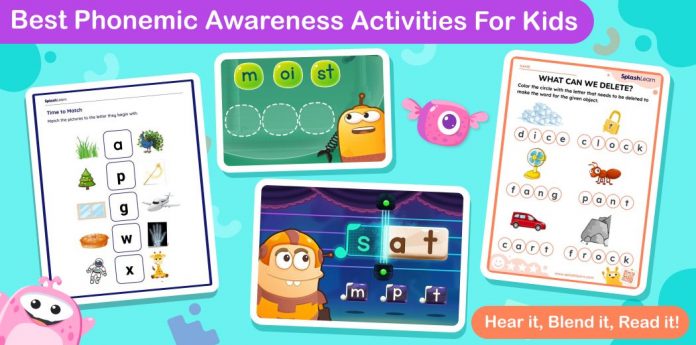Did you know phonemic awareness is one of the strongest predictors of a child’s reading success? Research shows that children who engage in phonemic awareness activities early on are more likely to become confident and fluent readers. The National Reading Panel found that teaching phonemic awareness significantly improves children’s reading and spelling abilities.
Math & ELA | PreK To Grade 5
Kids see fun.
You see real learning outcomes.
Watch your kids fall in love with math & reading through our scientifically designed curriculum.
Parents, try for free Teachers, use for free
Additionally, without direct instructional support, nearly 25% of middle-class first graders—and an even higher percentage of children from less literacy-rich environments—struggle with phonemic awareness, which can lead to challenges in learning to read and write.
But what exactly is phonemic awareness, and how can you teach it in a fun and meaningful way? Phonemic awareness is one part of the larger skill set known as phonological awareness. While phonological awareness provides the foundation, phonemic awareness focuses specifically on recognizing and manipulating the individual sounds (phonemes) in words. In this blog, we’ll explore engaging phonemic awareness activities that parents can seamlessly include in their child’s daily routine or teachers can integrate into the classroom to support their literacy journey.
What is Phonemic Awareness?
Phonemic awareness is the ability to hear, identify, and play with the individual sounds (called phonemes) in words. Phonemes are the smallest sounds in a word that can change its meaning. For example, in the word “cat,” if you change the /c/ sound to /b/, it becomes “bat.”
Examples of Phonemic Awareness Tasks
- Identifying the initial, middle, or final sounds in words (e.g., identifying the /b/ sound in “bat”).
- Blending individual sounds to form a word (e.g., /k/ + /æ/ + /t/ = “cat”).
- Breaking a word into its individual sounds (e.g., segmenting “dog” into /d/ + /ɒ/ + /g/).
- Deleting or substituting sounds in words (e.g., removing the /s/ sound from “spin” to make “pin”).
Is Phonemic Awareness and Phonological Awareness Same?
While phonemic awareness focuses specifically on recognizing and manipulating individual phonemes, phonological awareness is a broader term that includes the ability to recognize and work with all the sounds in spoken language, including phonemes, syllables, and rhymes. Phonemic awareness is a subset of phonological awareness.
Think of phonological awareness as the umbrella skill and phonemic awareness as one of its key components. For example, when a child claps to identify the number of syllables in a word (e.g., ba-na-na = three syllables), they are demonstrating phonological awareness, but not phonemic awareness. Similarly, recognizing rhyming words like cat and hat also falls under phonological awareness.
21 Fun Grade-Wise Activities & Games to Boost Phonemic Awareness
6 Fun Phonemic Awareness Activities And Games For Preschoolers
Preschool is a critical period for build early literacy skills. Here are 6 fun and engaging phonemic awareness activities designed to help children recognize sounds, understand simple word structures, and begin connecting oral language to written symbols. These activities focus on auditory and verbal skills that are essential for reading readiness.
1. Rhyme Time Game
What will the child learn: Rhyming
These interactive games are designed to develop your child’s rhyming and phonemic awareness skills step by step. A playful character will guide them through activities such as matching rhyming pairs, completing words by identifying missing sounds, and connecting tiles based on similar sound patterns. Each activity encourages your child to listen closely, sound out phonemes, and recognize word families, making it both an engaging and educational experience.
Build phonemic awareness with rhymes
Choose a game to practice word families like “AT,” “IT,” and more!
2. “I Spy” First Sounds
What will the child learn: Initial Sound Recognition
This classic game is a fun way to practice recognizing the beginning sounds of words. To play, look around the room or classroom and say, “I spy something that starts with the /s/ sound.” Encourage kids to find objects like “sun” or “sock.” Use words with distinctive, easy-to-hear sounds, such as “car” or “bee,” to make it engaging and simple for preschoolers to identify.
3. Listening with Closed Eyes
What will the child learn: Auditory Discrimination
This activity involves asking your child to identify sounds while their eyes are closed. Without visual help, children must focus on auditory input alone, which enhances their phonemic recognition. You might say “m” or “s” and have them identify the sound. This simple game improves listening skills and aids in their ability to recognize and differentiate sounds in words.
4. Make Some Noise
What will the child learn: Sound Identification, Memory
In this fun activity, children create and identify sounds using items like whistles, pots and pans, bells, or bubble wrap. Have them listen carefully to each sound, guess what made it, and describe it in a full sentence, such as “That was a bell ringing.”
5. Silly Tongue Twisters
What will the child learn: Articulation, Phonological Awareness
Help them practice tongue twisters with repeated sounds, such as “Miss Mouse makes marvelous meatballs” for the “M” sound. This can help children become more aware of different sounds in words.
6. Rhyming Riddles
What will the child learn: Rhyming
Create playful riddles where one word is slightly altered, like saying “poctor” instead of “doctor.” Ask your child to identify the correct word and explain what sounds were different. This can be a fun way to practice phonemic awareness in the classroom.
5 Phonemic Awareness Games and Activities for Kindergarteners
Kindergarten is a formative time when children begin actively engaging with more structured learning activities that build on their preschool experiences. The activities at this level are designed to further develop phonemic awareness and introduce children to basic literacy skills that are crucial for reading and writing.
1. Rhyming Pairs
What will the child learn: Rhyming, Phonemic Recognition
Use matching rhyme cards to teach children how words sound alike. For example, pair cards with images or words like “cat” and “hat” or “sun” and “fun.” Encourage children to say each pair out loud and explain how they rhyme. This activity can help children become more aware of the sounds in words and how they relate to each other.
2. Phoneme Sound Match
What will the child learn: Sound Identification, Visual Association
In the following worksheets, kids will match pictures to the letters they begin with. For example, the picture of a peacock is matched with the letter P, and the picture of a window is matched with the letter W. This activity helps children connect initial sounds with their corresponding letters while improving their ability to recognize and associate sounds visually.
What will the child learn: Syllable Counting
Turn your grocery trip into a fun learning experience by having your child count the syllables in food names. For example, ask, “How many syllables are in ‘banana’?” (ba-na-na = 3 syllables). You can make it more interactive by challenging them to clap, tap, or jump for each syllable.
4. Fill in the Blanks
What will the child learn: Phoneme Identification, Spelling
In the following worksheets, ask students to identify the correct ending sound to complete each word. For example, in the word “sni__”, they can choose between “ss” or “ff” to correctly complete it as “sniff.” Similarly, for “ja__,” they’ll pick “zz” to form “jazz.” This activity strengthens their ability to recognize ending sounds and associate them with the correct spelling.
5. Sound Scavenger Hunt
What will the child learn: Sound Recognition, Active Listening
Choose a letter sound & ask your child to find things around your house that start with that sound. For instance, if you choose the sound “s,” they might find a sock or a spoon.
5 Best Phonemic Awareness Activities for 1st Graders
In 1st grade, children deepen their phonemic awareness with more complex activities that hone their phoneme blending, pattern recognition, and rhythm skills. Here are some fun and easy phonemic awareness activities for 1st graders:
1. Word Families Game
What will the child learn: Phoneme Pattern Recognition
In the following worksheets, kids will connect pictures to their rhyming pairs. For example, match “car” with “star” or “bat” with “cat.” This fun and interactive activity helps children recognize rhyming words, building their phonemic awareness and understanding of word families.
Find the perfect rhyme pair
Match rhyming words and pictures to strengthen the ability to recognize sound patterns.
2. Phoneme Blending
What will the child learn: Sound Blending, Decoding Words
If you are looking for fun activities to teach phonemic awareness, these games are some of the best options. These online games teach children how to blend individual sounds to form complete words. Guided by playful characters, children listen to phonemes (e.g., /m/ + /oi/ + /st/ for “moist”) and combine them to create words. These games involve rearranging sounds to build new words, helping children deepen their understanding of sound patterns and word structure.
Blend sounds to build new words
Watch kids combine sounds like “m” and “oi” to form words like “moist.”
3. Count and Clap
What will the child learn: Syllable Counting, Rhythm Recognition
Line up the children and sing a song with words of different syllables. Have the children clap for each syllable. This activity helps children develop an understanding of syllables and rhythm.
4. Sound Blending Song
What will the child learn: Blending Sounds, Fluency
Sing a song with easy words to spell, and have children repeat the words. This helps children practice blending sounds to form words.
5. Word Family Sort
What will the child learn: Pattern Recognition, Categorization
In the following worksheets, kids identify and sort word family. For example, children color the clouds that contain words from the -at word family (e.g., “cat,” “bat,” “rat”) and leave out words that don’t belong (e.g., “pit,” “cut”). Next, they write any four words from the -at family in the space provided. This activity reinforces their ability to recognize rhyming patterns and understand word families, essential for building decoding and spelling skills.
Crack the code of word families
Help kids organize words like “dust” and “just” into the right word families!
5 Phonemic Awareness Activities for 2nd Graders
By 2nd grade, students are expected to engage with more complex phonemic awareness tasks that enhance their reading and spelling abilities. Here are some activities that focus on phoneme manipulation, complex word formation, and linguistic analysis, fostering a deeper understanding of language structure and use.
1. Phoneme Manipulation
What will the child learn: Advanced Phonemic Awareness, Decoding, and Encoding Skills
In the following worksheets ask them to add, delete, or change phonemes to create new words. For example, from “lead” they can make “read” by changing /l/ to /r/.
Transform words with phoneme manipulation
Experiment with sounds—delete, add, or replace phonemes to create new words.
2. Compound Word Challenge
What will the child learn: Vocabulary Expansion, Creative Language Formation
This activity combines two engaging worksheets to teach compound words. In the Winter Compound Words worksheet, children look at images in each row and combine them to form a compound word, such as “fruitcake” (fruit + cake) or “turtleneck” (turtle + neck). In the Matching Compound Words worksheet, children match words from two columns to create compound words, like “football” (foot + ball) or “watermelon” (water + melon). These exercises help children visualize how words combine, build vocabulary, and improve reading comprehension.
Compound word fun: Match, combine, and learn!
Help your child blend simple words into meaningful compounds!
3. Segmentation Practice
Skills Gained: Phoneme Segmentation, Spelling Accuracy
These engaging online games help children practice segmenting words into individual sounds, whether at home or in the classroom. Guided by fun and interactive characters, children break down words like “at” into /a/ and /t/ or “am” into /a/ and /m/. Each game encourages them to identify and isolate sounds in words, building a strong foundation for decoding and spelling skills. The step-by-step approach ensures children grasp the concept of segmentation in a playful, stress-free environment.
Break the word, find the sound
Help kids break words like “am” and “an” into smaller phonemes!
4. Phoneme Deletion
Skills Gained: Phonemic Awareness, Analytical Thinking
In this worksheet kids identify which letter needs to be removed from a word to match the picture. For example, in “dice,” removing the letter “d” forms “ice,” matching the image. Similarly, in “pant,” removing the “t” forms “pan,” corresponding to the fan image. This activity helps children understand how deleting a phoneme changes a word, sharpening their phonemic awareness and spelling skills in a fun and interactive way.
Identify and delete sounds to form words
Teach kids how to remove specific letters to discover new words!
5. Sentence Segmentation
Skills Gained: Linguistic Analysis, Decoding Skills
Sentence Segmentation involves breaking down sentences into individual words and further into phonemes, which enhances children’s ability to analyze language at different levels. Present a sentence and have them segment it into individual words and phonemes. For instance, “The sun is shining” can be segmented as “The /s/ – /u/ – /n/ is /sh/ – /i/ – /n/ – /i/ – /ng/.”
5 Tips for Making Phonemic Awareness Activities Fun
- Incorporate Movement: Combine physical actions with phonemic tasks to keep children engaged. For example, have them jump for each syllable in a word or clap for every phoneme they hear. This integrates learning with play, making activities more interactive.
- Use Everyday Objects: Turn daily routines into phonemic awareness practice. While cooking, ask your child to identify the first sound of “pot,” “pan,” or “plate,” or count syllables in grocery items like “banana” or “cereal.” Using familiar items makes the activity relatable and easier to understand.
- Integrate Technology: Use interactive online games that emphasize phonemic awareness skills like blending, segmenting, and rhyming. These games often include characters, animations, and rewards, which keep children motivated while they learn essential skills.
- Use Worksheets for Variety: Include colorful and engaging worksheets that focus on skills like rhyming, blending, or phoneme deletion. Activities like matching rhyming pairs, filling in missing sounds, or forming compound words provide structured practice and keep children interested with visual elements.
- Make It Social: Turn activities into group games by involving siblings, friends, or classmates. For example, play “I Spy” with a focus on beginning sounds or organize a rhyming word relay. Collaborative tasks make learning more dynamic and enjoyable.
Conclusion
Incorporating these fun and educational phonemic awareness activities into your child’s routine is a fantastic way to enhance their language and reading skills. Whether through games that teach sound identification, rhyme, or phoneme manipulation, each activity is designed to engage your child in learning while ensuring they have a great time. This approach helps lay a solid foundation for successful reading and writing in the future.
Related Reading: How to Get Best Results While Teaching Phonics to Kids at Home
Frequently Asked Questions (FAQs)
Why is phonemic awareness important?
Phonemic awareness is crucial for reading success as it enables one to recognize and manipulate the individual sounds in words. This foundational skill helps in decoding words and greatly aids in learning to read and spell.
When should I introduce Phonemic awareness activities to my child?
Introducing phonemic awareness activities can start in preschool and should continue throughout the elementary school years.
What are some common phonemic awareness difficulties children may face?
Some children may struggle with phonemic awareness due to hearing or other learning challenges. However, most children can improve their phonemic awareness skills with appropriate support and intervention.
What is the difference between phonemic awareness and phonics?
Phonemic awareness is about recognizing and manipulating individual sounds in spoken words, while phonics is about linking those sounds to letters and learning how to read and spell.
What are some fun phonological awareness activities for kids?
Fun phonological awareness activities for kids include playing rhyming games, clapping out syllables in words, identifying beginning sounds in objects (e.g., “What starts with ‘B’?”), and singing songs with alliteration. These activities make learning sounds engaging and interactive.























































